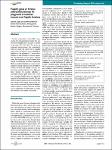Flagellin genes of Yersinia enterocolitica biotype 1A: playground of evolution towards novel flagellin functions
Lepka, Daniela
Wilharm, Gottfried
Yersinia enterocolitica strain 8081, representing the high-pathogenic biotype 1B, harbours three flagellin genes arranged in tandem in the order fliC3, fliC, fliC2. The genes are organized monocistronic but coordinately expressed under the control of the flagellar sigma factor. No sequence data is available on flagellins of low-pathogenic Y. enterocolitica biotypes 2-5 and of biotype 1A strains, appearing non-pathogenic in the mouse infection model. We sequenced the flagellin genes of ten biotype 1A and biotype 4 isolates, respectively. While we could not identify any sequence polymorphism among flagellin genes of biotype 4 isolates, we found that biotype 1A strains harbour three variable flagellin genes. Moreover, three biotype 1A isolates exhibited a rearranged flagellin gene order and at least one rearranged flagellin gene was apparently acquired by horizontal gene transfer. The variability of flagellin genes seems to mirror evolution towards novel flagellin functions. By contrast, strictly conserved flagellins of biotype 4 isolates point at a strong selection pressure such as expected to be imposed by an important function in the context of infection.
Dateien zu dieser Publikation
Keine Lizenzangabe

